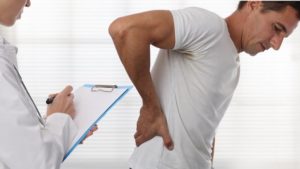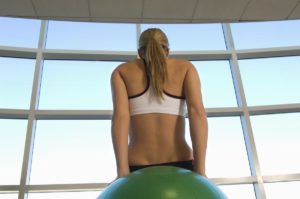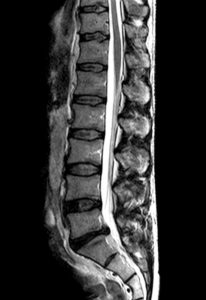Doing your best to cope with lower back pain?
You’re not the only one – according to the American Chiropractic Association, about 31 million people around the country will be dealing with lower back pain at any given time. The effects of this problem run the gamut from minor annoyance to severe, crippling pain that can greatly reduce a person’s quality of life.
Naturally, anyone with this condition has at least two questions:
What causes lower back pain and how can it be treated?
In the sections below, it’s our aim to answer both.
Read on to first gain a thorough understanding of your lower back pain problem, then begin your journey to successfully managing it and – we hope – kicking lower back pain out of your life for good!
Understanding the Lower Back
First things first: the technical name for your lower back is the LUMBAR SPINE. This term simply refers to the bottom section of your spine. Your lower back is composed of five vertebrae, along with muscles, joints, and shock absorbers known as disks.
The lumbar spine is a complex structure that supports the back and allows you to bend over and twist your upper body.
It also lies at the center of any lower back pain problem.
Because it’s so complex and has so many moving parts, there are many potential causes of lower back pain. We’ll look at some of the most prominent of these in the next section.
What Causes Lower Back Pain?
1. Strain or Sprain of the Back
A strain or sprain is the kind of back pain you might get from quickly lifting a heavy object, or simply making an awkward movement. It may be sudden or build up over time.
Muscle strain occurs when the muscle is stretched too far – it’s for this reason that the condition is known as having a “pulled muscle.”
A sprain, on the other hand, is when the muscle ligament has been completely torn.
Whether you’re experiencing a strain or a sprain, you may get muscle spasms, have a tough time maintaining posture, or feel incredibly stiff in your back.
2. Radiculopathy
You may have noticed that, sometimes, pain in the leg or foot seems to come along with lower back pain. This is called “radiculopathy” and occurs because the lumbar spine acts as a central hub for nerves. These nerves run from the spinal cord – situated directly above the lumbar spine – to your legs and feet below.
When they’re compressed or inflamed, pain is the result.
This pain is typically (but not always) an electrical, stinging pain known as sciatica.
3. Osteoarthritis
The 5 vertebrae of the lower spine are connected to each other with what are called facet joints. These joints can become damaged and therefore inflamed as the body attempts to respond to the problem, causing great amounts of pain.
4. Degenerative Disc Disease
Unfortunately, the risk of lower back pain increases as we get older, mainly as a result of degenerative disk disease.
Keep in mind that degenerative disc disease is a bit of a misleading term – it is not degenerative, nor is it a disease. For whatever reason, though, this phrase has stuck.
Believe it or not, degenerative disc disease is actually completely normal for people to develop as they age.
Remember those “shock absorbers” we mentioned earlier? The disks between vertebrae?
These are normally filled with water, helping the disks do their job of shock absorption. As we get older, however, this fluid begins to drain, meaning the disks are not as shock resistant as they once were.
As such, they can be become damaged, leading to pain or even more serious problems like hernia or stenosis.
5. Herniated Disc
A herniated disc is one in which the interior has pushed outside the disk wall. Though they can occur anywhere along the spine, they occur most often in – you guessed it – the lower back.
Herniated disks, also known as ruptured disks, can cause pain by pressing on one of the many nerves that surround the lumbar spine. This is why, if you have a ruptured disk, you’ll typically feel pain in your leg or buttocks – the signal is being transmitted by that nerve.
As such, if you have leg pain worse than back pain, this is an indication that the disk is pressing with significant force on a nerve.
6. Spinal Stenosis
Your spinal cord makes its way through what is called the spinal canal – the spinal canal is just the “tunnel” that is created by the openings in vertebrae.
Spinal stenosis is a narrowing of your spinal canal, which can make it so that the spinal cord and connected nerves don’t have enough room. Physical pressure is put on them, resulting in pain.
Lumbar spinal stenosis is the most common type, so if you have lower back pain and/or sciatica in the legs, you may be experiencing this condition.
How to Relieve Lower Back Pain

Just as there are many causes of lower back pain, there are many different treatments for lower back pain from lifestyle changes to non-invasive treatments and, in more severe cases surgical procedures
If you’re simply dealing with a strain or even a sprain, a bit of rest and over the counter painkillers may be enough for you – the body does have enormous restorative properties, after all.
However, it’s always best to meet with a professional, especially if the problem is chronic or intensely painful. Something like a herniated disk will absolutely not go away with a bit of rest and time.
Non-Invasive Treatments for Lower Back Pain
1. Exercise
Certain exercises and stretches can be beneficial for your lower back pain by helping to loosen and soften stiff muscles.
However, be sure to only perform exercises that are recommended to you by a physician knowledgeable in the funcitoning of the spine! Moving the wrong way may worsen rather than alleviate back pain.
2. Steroid Injections
If inflammation is determined to be the cause of your pain, targeted steroid injections will help to relieve this.
3. Painkillers
Certain drugs such as NSAIDs and opioids are well-known for their pain-relieving qualities and can certainly help with back pain.
However, it’s important to be sure this isn’t only masking the true issue and should really only be administered as a short-term treatment – it’s important to get to the root of the problem so that you don’t become dependent.
Surgery for Lower Back Pain
1. Discectomy
Discectomy is all about removing an object that is pressing on a nerve and causing pain, making it the ideal choice of treatment for a herniated disk. The part of the disk that is pushing on a nerve is removed.
Typically, microscopes are used and a “microdiscectomy” is performed, allowing the surgeon to make a smaller incision and so make the procedure less invasive.
2. Laminectomy
Laminectomy is a type of “decompression surgery” – meaning it relieves pressure – like discectomy. This method removes a piece of bone that covers the spinal canal (the lamina) and so eases up pressure on the spinal cord. This is a good option for cases of spinal stenosis.
Laminectomies are also sometimes performed as an adjunct to discectomies if the lamina needs to be removed in order to give the surgeon a better view of the herniated disk.
3. Spinal Fusion
Spinal fusion is a technique mostly used in cases of problems with spinal alignment such as scoliosis.
Here, vertebrae are fused together using a healthy bone graft – sort of like a welding procedure – and then secured in place. Replacing a problematic disk with an artificial disk is an alternative solution to spinal fusion.
4. Laser Spine Surgery
Laser spinal surgery, or PLDD, is a minimally invasive procedure that treats back pain, and is a good alternative to spinal fusion. No incision is required for laser spine surgery, because the treatment involves inserting a small laser through a needle directly into a herniated disc and using the heat from the laser to evaporate a small portion to prevent it from bulging. The benefits of PLDD over spinal fusion are the much faster recovery times, and less risk of complications since it doesn’t involve open surgery or removing portions of the spine.
Contact AllSpine Today
Are you dealing with lower back pain? Our mission at AllSpine Laser and Surgery is to pinpoint the exact cause of your back pain and then treat it in the most effective way possible. We offer every type of treatment for lower back pain that’s available, from life advice tips and non-invasive techniques to surgical solutions.
Back pain doesn’t have to limit what you can and can’t do, and we’re here to help!


